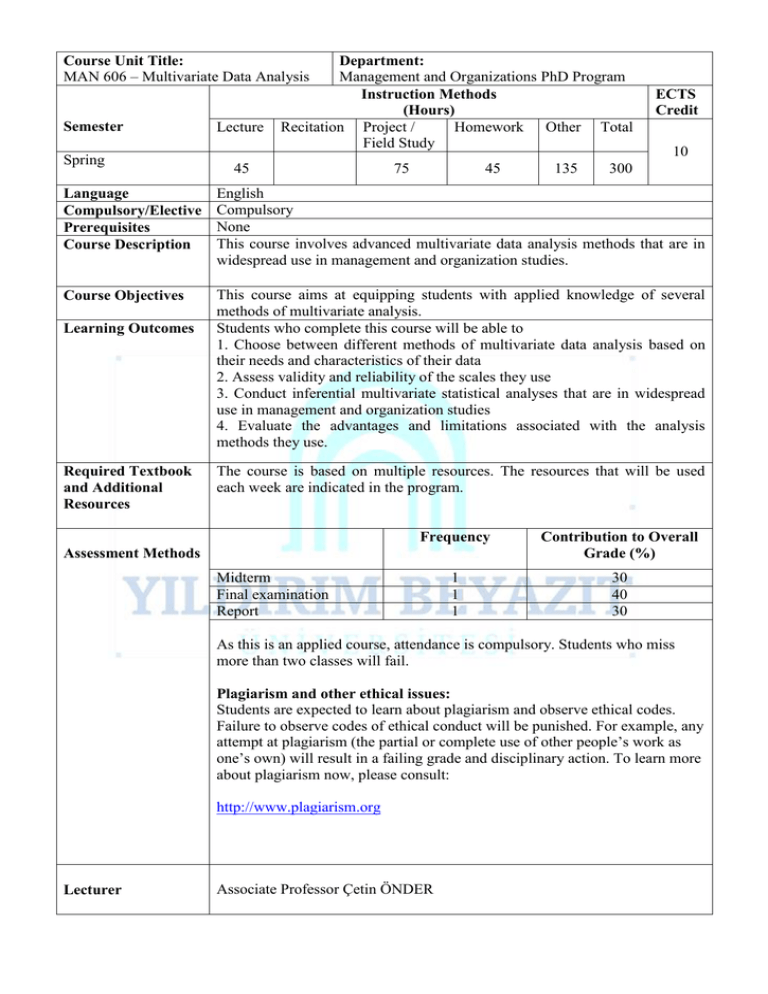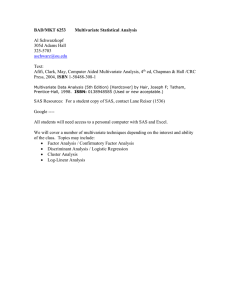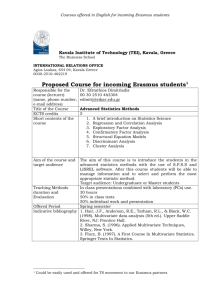Course Unit Title: MAN 606 – Multivariate Data Analysis Department
advertisement

Course Unit Title: MAN 606 – Multivariate Data Analysis Semester Spring Lecture Department: Management and Organizations PhD Program Instruction Methods (Hours) Recitation Project / Homework Other Total Field Study 45 75 45 135 ECTS Credit 10 300 Language Compulsory/Elective Prerequisites Course Description English Compulsory None This course involves advanced multivariate data analysis methods that are in widespread use in management and organization studies. Course Objectives This course aims at equipping students with applied knowledge of several methods of multivariate analysis. Students who complete this course will be able to 1. Choose between different methods of multivariate data analysis based on their needs and characteristics of their data 2. Assess validity and reliability of the scales they use 3. Conduct inferential multivariate statistical analyses that are in widespread use in management and organization studies 4. Evaluate the advantages and limitations associated with the analysis methods they use. Learning Outcomes Required Textbook and Additional Resources The course is based on multiple resources. The resources that will be used each week are indicated in the program. Frequency Contribution to Overall Grade (%) 1 1 1 30 40 30 Assessment Methods Midterm Final examination Report As this is an applied course, attendance is compulsory. Students who miss more than two classes will fail. Plagiarism and other ethical issues: Students are expected to learn about plagiarism and observe ethical codes. Failure to observe codes of ethical conduct will be punished. For example, any attempt at plagiarism (the partial or complete use of other people’s work as one’s own) will result in a failing grade and disciplinary action. To learn more about plagiarism now, please consult: http://www.plagiarism.org Lecturer Associate Professor Çetin ÖNDER COURSE CONTENT Week Topic 1 Validity and reliability 2 3 4 Exploratory factor analysis (EFA) Structural Equations Modeling: Core constructs, methods and tools Measurement model and confirmatory factor analysis (CFA) Readings Hair, J.F., Anderson, R.E., Tatham, R.L., Black, W.C. (1998) Multivariate Data Analysis, 5th Edition, Prentice Hall, Upper Saddle River, New Jersey, Ch. 3, “Factor Analysis”, p. 87-138. Hair, J.F., Anderson, R.E., Tatham, R.L., Black, W.C. (1998) Multivariate Data Analysis, 5th Edition, Prentice Hall, Upper Saddle River, New Jersey, Ch. 11, “Structural Equation Modeling”, p. 577-666. MacCallum, R.C., Austin, J.T. (2000) Applications of structural equation modeling in psychological research, Annual Review of Psychology, 51: 201226. Byrne, B.M. (2001) Structural Equation Modeling With AMOS : Basic Concepts, Applications, and Programming. Mahwah, NJ: Lawrence Erlbaum. [Application 1: “Testing for the Factorial Validity of a Theoretical Construct (First-Order CFA Model)”, p. 57-97] Noar, S.M. (2003) The role of structural equation modeling in scale development, Structural Equation Modeling, 10(4): 622-647. 5 6 Measurement model and confirmatory factor analysis (CFA) Multi-group CFA and measurement invariance Edwards, J.R. (2001) Multidimensional constructs in organizational behavior research: An integrative analytical framework, Organizational Research Methods, 4 (2): 144-192. Vandenberg, R.J., Lance, C.E. (2000) A review and synthesis of the measurement invariance literature: Suggestions, practices, and recommendations for organizational research. Organizational Research Methods, 3: 4-69. Byrne, B.M. (2004) Testing for multigroup invariance using AMOS graphics: A road less traveled, Structural Equation Modeling, 11(2): 272300. Byrne, B.M. (2001), Application 4, “Testing for the Validity of a Causal Structure”, p. 142-172. 7 Path analysis: Direct and mediated effects 8 Multi-group path analysis 9 Midterm Hunt, S.D., Morgan, R.M. (1994) Organizational commitment: One of many commitments or key mediating construct? Academy of Management Journal, 37(6): 1568-1587. Byrne, B.M. (2001) Application 8: “Testing for Invariant Pattern of Causal Structure”, p. 247-266. Hair, J.F., Anderson, R.E., Tatham, R.L., Black, W.C. (1998) Multivariate Data Analysis, 5th Edition, Prentice Hall, Upper Saddle River, New Jersey, Ch. 4, “Multiple Regression Analysis”, p. 141-216. 10 11 12 Multivariate regression analysis Discriminant analysis and logistic regression Multivariate analysis of variance (MANOVA) Wasti, S.A. (2003) Organizational commitment, turnover intentions and the influence of cultural values. Journal of Occupational and Organizational Psychology, 76: 303-321. Hair, J.F., Anderson, R.E., Tatham, R.L., Black, W.C. (1998) Multivariate Data Analysis, 5th Edition, Prentice Hall, Upper Saddle River, New Jersey, Ch. 5, “Multiple Discriminant Analysis and Logistic Regression”, p. 239-325. Hair, J.F., Anderson, R.E., Tatham, R.L., Black, W.C. (1998) Multivariate Data Analysis, 5th Edition, Prentice Hall, Upper Saddle River, New Jersey, Ch. 6, “Multivariate Analysis of Variance”, p. 326-386. Hair, J.F., Anderson, R.E., Tatham, R.L., Black, W.C. (1998) Multivariate Data Analysis, 5th Edition, Prentice Hall, Upper Saddle River, New Jersey, Ch. 9, “Cluster Analysis”, p. 469-568. 13 Cluster analysis 14 Analysis support session for your reports 15 Presentations Wasti, S.A. (2005) Commitment profiles: Combinations of organizational commitment forms and job outcomes. Journal of Vocational Behavior, 67: 290-308.




